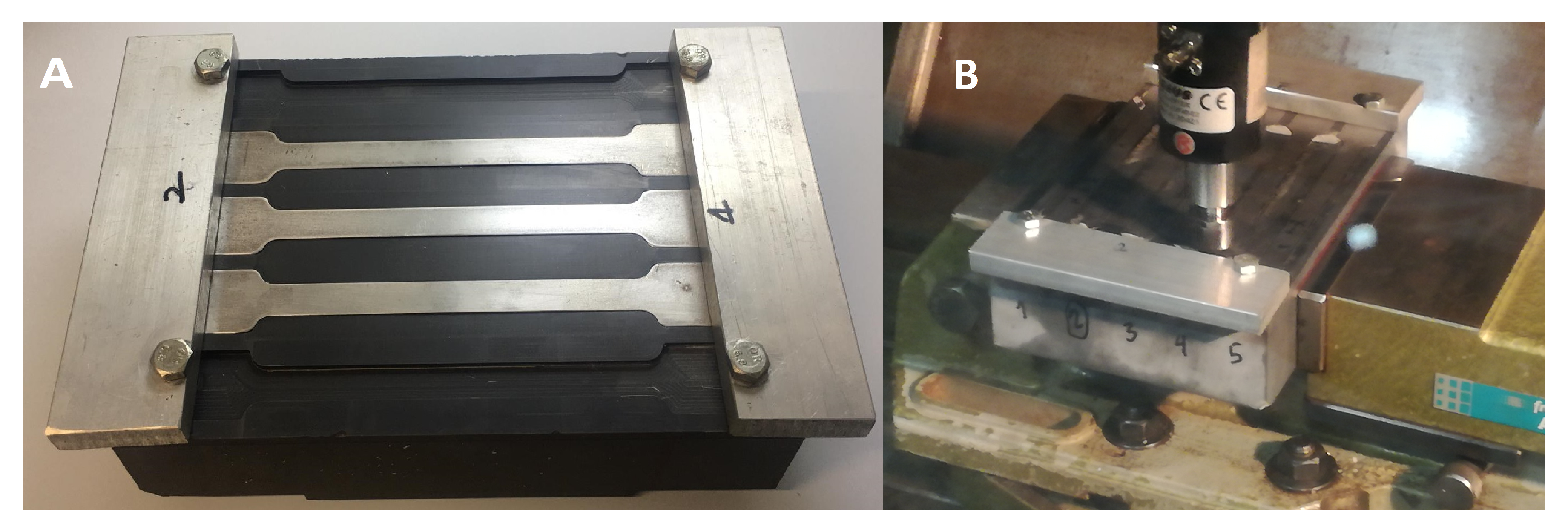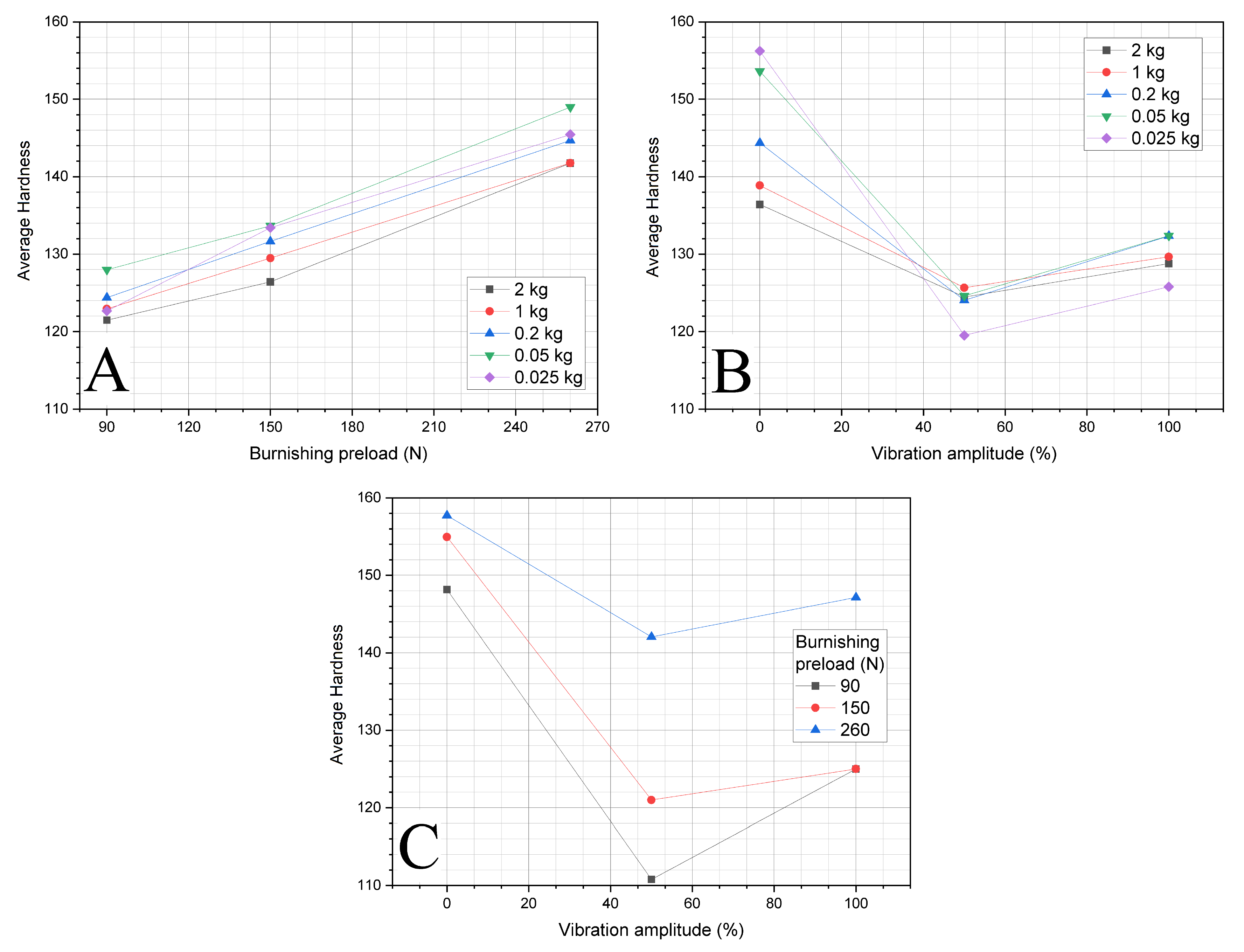Mechanical Strengthening in S235JR Steel Sheets through Vibration-Assisted Ball Burnishing
Abstract
:1. Introduction
2. Experimental Approach
2.1. Methodology
2.2. Specimen Preparation
2.3. Ball Burnishing Setup
2.3.1. Ball Burnishing Tool
2.3.2. Burnishing Preload
2.3.3. Vibration Amplitude
2.3.4. Experimental Design
2.3.5. Other Parameters
2.4. Response Indicators
2.4.1. Microhardness Measurement
2.4.2. Tensile Testing
3. Results and Discussion
3.1. Microhardness Measurement
3.2. Tensile Testing
4. Conclusions
Author Contributions
Funding
Conflicts of Interest
Abbreviations
| A | Vibration amplitude |
| BB | Ball burnishing |
| Deformation at ultimate strength | |
| F | Burnishing preload |
| FHD | Full high definition |
| HD | High definition |
| k | Strength index |
| n | Strain hardening coefficient |
| Average surface roughness | |
| RM | Resilience module |
| Yield stress | |
| UTS | Ultimate tensile strength |
| UVABB | Ultrasonic vibration-assisted ball burnishing |
| VABB | Vibration-assisted ball burnishing |
References
- Iswanto, P.; Yaqin, R.; Sadida, H. Influence of shot peening on surface properties and corrosion resistance of implant material AISI 316L. Metalurgija 2020, 59, 309–312. [Google Scholar]
- Iswanto, P.; Maliwemu, E.; Malau, V.; Imaduddin, F.; Sadida, H. Surface roughness, hardness, and fatigue-corrosion characteristic of AISI 316L by shot peening. Metalurgija 2020, 59, 183–186. [Google Scholar]
- Swirad, S.; Pawlus, P. The Effect of Ball Burnishing on Tribological Performance of 42CrMo4 Steel under Dry Sliding Conditions. Materials 2020, 13, 2127. [Google Scholar] [CrossRef] [PubMed]
- Teimouri, R.; Amini, S.; Guagliano, M. Analytical modeling of ultrasonic surface burnishing process: Evaluation of residual stress field distribution and strip deflection. Mater. Scie. Eng. A 2019, 747, 208–224. [Google Scholar] [CrossRef]
- García-Granada, A.A.; Gomez-Gras, G.; Jerez-Mesa, R.; Travieso-Rodriguez, J.A.; Reyes, G. Ball-burnishing effect on deep residual stress on AISI 1038 and AA2017-T4. Mater. Manuf. Process. 2017, 32, 1279–1289. [Google Scholar] [CrossRef]
- Takada, Y.; Sasahara, H. Effect of tip shape of frictional stir burnishing tool on processed layer’s hardness, residual stress and surface roughness. Coatings 2018, 8, 32. [Google Scholar] [CrossRef] [Green Version]
- Estevez-Urra, A.; Llumà, J.; Jerez-Mesa, R.; Travieso-Rodriguez, J.A. Monitoring of Processing Conditions of an Ultrasonic Vibration-Assisted Ball-Burnishing Process. Sensors 2020, 20, 2562. [Google Scholar] [CrossRef]
- Bozdana, A.T.; Gindy, N. Comparative experimental study on effects of conventional and ultrasonic deep cold rolling processes on Ti–6Al–4V. Mater. Sci. Technol. 2008, 24, 1378–1384. [Google Scholar] [CrossRef]
- Gómez-Gras, G.; Travieso-Rodríguez, J.A.; González-Rojas, H.A.; Nápoles-Alberro, A.; Carrillo, F.J.; Dessein, G. Study of a ball-burnishing vibration-assisted process. Proc. Inst. Mech. Eng. Part B J. Eng. Manuf. 2015, 229, 172–177. [Google Scholar] [CrossRef] [Green Version]
- Siu, K.; Ngan, A.; Jones, I. New insight on acoustoplasticity–ultrasonic irradiation enhances subgrain formation during deformation. Int. J. Plasticity 2011, 27, 788–800. [Google Scholar] [CrossRef]
- Green, R. Non-linear effects of high-power ultrasonics in crystalline solids. Ultrasonics 1975, 13, 117–127. [Google Scholar] [CrossRef]
- Amini, S.; Bagheri, A.; Teimouri, R. Ultrasonic-assisted ball burnishing of aluminum 6061 and AISI 1045 steel. Mater. Manuf. Process. 2018, 33, 1250–1259. [Google Scholar] [CrossRef]
- Jerez-Mesa, R.; Landon, Y.; Travieso-Rodriguez, J.A.; Dessein, G.; Lluma-Fuentes, J.; Wagner, V. Topological surface integrity modification of AISI 1038 alloy after vibration-assisted ball burnishing. Surf. Coat. Technol. 2018, 349, 364–377. [Google Scholar] [CrossRef] [Green Version]
- Travieso-Rodríguez, J.A.; Gras, G.G.; Peiró, J.J.; Carrillo, F.; Dessein, G.; Alexis, J.; Rojas, H.G. Experimental study on the mechanical effects of the vibration-assisted ball-burnishing process. Mater. Manuf. Process. 2015, 30, 1490–1497. [Google Scholar] [CrossRef] [Green Version]
- Saldaña-Robles, A.; Plascencia-Mora, H.; Aguilera-Gómez, E.; Saldaña-Robles, A.; Marquez-Herrera, A.; Diosdado-De la Peña, J.A. Influence of ball-burnishing on roughness, hardness and corrosion resistance of AISI 1045 steel. Surf. Coat. Technol. 2018, 339, 191–198. [Google Scholar] [CrossRef]
- Travieso-Rodriguez, J.A.; Gomez-Gras, G.; Dessein, G.; Carrillo, F.; Alexis, J.; Jorba-Peiro, J.; Aubazac, N. Effects of a ball-burnishing process assisted by vibrations in G10380 steel specimens. Int. J. Adv. Manuf. Technol. 2015, 81, 1757–1765. [Google Scholar] [CrossRef] [Green Version]
- Pande, S.; Patel, S. Investigations on vibratory burnishing process. Int. J. Mach. Tool Des. Res. 1984, 24, 195–206. [Google Scholar] [CrossRef]
- Pak, A.; Mahmoodi, M.; Safari, M. Experimental Investigation of the Effects of Initial Surface Roughness on Ultrasonic Assisted Ball Burnishing of Al6061-T6. Modares Mech. Eng. 2019, 20, 87–95. [Google Scholar]
- Teimouri, R.; Amini, S.; Bami, A.B. Evaluation of optimized surface properties and residual stress in ultrasonic assisted ball burnishing of AA6061-T6. Measurement 2018, 116, 129–139. [Google Scholar] [CrossRef]
- Rodríguez, A.; de Lacalle, L.L.; Celaya, A.; Lamikiz, A.; Albizuri, J. Surface improvement of shafts by the deep ball-burnishing technique. Surf. Coat. Technol. 2012, 206, 2817–2824. [Google Scholar] [CrossRef]
- Huuki, J.; Hornborg, M.; Juntunen, J. Influence of ultrasonic burnishing technique on surface quality and change in the dimensions of metal shafts. J. Eng. 2014, 2014, 124247. [Google Scholar] [CrossRef] [Green Version]
- Lu, L.; Sun, J.; Li, L.; Xiong, Q. Study on surface characteristics of 7050-T7451 aluminum alloy by ultrasonic surface rolling process. Int. J. Adv. Manuf. Technol. 2016, 87, 2533–2539. [Google Scholar] [CrossRef]
- Jerez-Mesa, R.; Travieso-Rodriguez, J.A.; Gomez-Gras, G.; Lluma-Fuentes, J. Development, characterization and test of an ultrasonic vibration-assisted ball burnishing tool. J. Mater. Process. Technol. 2018, 257, 203–212. [Google Scholar] [CrossRef] [Green Version]
- Jerez-Mesa, R.; Travieso-Rodríguez, J.A.; Landon, Y.; Dessein, G.; Lluma-Fuentes, J.; Wagner, V. Comprehensive analysis of surface integrity modification of ball-end milled Ti-6Al-4V surfaces through vibration-assisted ball burnishing. J. Mater. Process. Technol. 2019, 267, 230–240. [Google Scholar] [CrossRef]
- Gomez-Gras, G.; Travieso-Rodriguez, J.A.; Jerez-Mesa, R.; Lluma-Fuentes, J.; de la Calle, B.G. Experimental study of lateral pass width in conventional and vibrations-assisted ball burnishing. Int. J. Adv. Manuf. Technol. 2016, 87, 363–371. [Google Scholar] [CrossRef] [Green Version]







| Element | C | Si | Mn | P | S | Cr | Ni |
|---|---|---|---|---|---|---|---|
| % weight | 0.11 | 0.03 | 0.056 | 0.007 | 0.005 | 0.07 | 0.03 |
| Parameter | Levels | ||
|---|---|---|---|
| I | II | III | |
| Burnishing force, F (N) | 90 | 150 | 260 |
| Vibration amplitude, A (%) | 0 | 50 | 100 |
| Feed Velocity (mm/min) | Lateral Offset between Passes b (mm) | Number of Passes N |
|---|---|---|
| 900 | 0.25 | 1 |
| Load (kg) | a | b | c | |||
|---|---|---|---|---|---|---|
| 2 | 189 ± 167 | −82 ± 159 | 350 ± 1028 | 10 ± 26 | −0.08 ± 0.22 | 0.913 |
| 1 | 156 ± 21 | −48 ± 18 | 121 ± 143 | 5 ± 4 | −0.04 ± 0.04 | 0.936 |
| 0.2 | 155 ± 12 | −54 ± 13 | 71 ± 64 | 6 ± 4 | −0.05 ± 0.03 | 0.954 |
| 0.05 | 161 ± 16 | −57 ± 18 | 63 ± 67 | 7 ± 5 | −0.05 ± 0.04 | 0.913 |
| 0.025 | 166 ± 15 | −62 ± 16 | 74 ± 77 | 9 ± 5 | −0.07 ± 0.05 | 0.961 |
| F (N) | A (%) | (MPa) | (MPa) | (%) | (MPa) | (MPa) | k (MPa) | n |
|---|---|---|---|---|---|---|---|---|
| 0 | 0 | 203 ± 6 | 320 ± 8 | 0.23 ± 0.02 | 0.50 ± 0.02 | 17 ± 15 | 527 ± 14 | 0.21 ± 0.01 |
| 90 | 0 | 225 ± 8 | 318 ± 6 | 0.24 ± 0.01 | 0.56 ± 0.05 | 158 ± 20 | 402 ± 21 | 0.35 ± 0.04 |
| 90 | 50 | 233 ± 4 | 322 ± 2 | 0.21 ± 0.01 | 0.58 ± 0.05 | 144 ± 8 | 410 ± 5 | 0.31 ± 0.01 |
| 90 | 100 | 228 ± 6 | 318 ± 7 | 0.22 ± 0.02 | 0.59 ± 0.02 | 116 ± 63 | 430 ± 55 | 0.29 ± 0.09 |
| 150 | 0 | 232 ± 7 | 318 ± 6 | 0.19 ± 0.03 | 0.63 ± 0.26 | 176 ± 17 | 376 ± 15 | 0.35 ± 0.01 |
| 150 | 50 | 245 ± 1 | 328 ± 3 | 0.20 ± 0.01 | 0.67 ± 0.01 | 182 ± 19 | 382 ± 16 | 0.35 ± 0.02 |
| 150 | 100 | 251 ± 8 | 321 ± 3 | 0.21 ± 0.01 | 0.68 ± 0.08 | 211 ± 11 | 356 ± 7 | 0.42 ± 0.03 |
| 260 | 0 | 278 ± 6 | 330 ± 3 | 0.19 ± 0.04 | 0.72 ± 0.29 | 249 ± 17 | 343 ± 15 | 0.49 ± 0.03 |
| 260 | 50 | 285 ± 7 | 328 ± 3 | 0.17 ± 0.01 | 0.84 ± 0.11 | 260 ± 25 | 326 ± 5 | 0.52 ± 0.10 |
| 260 | 100 | 285 ± 9 | 330 ± 8 | 0.16 ± 0.02 | 0.83 ± 0.04 | 255 ± 9 | 317 ± 14 | 0.48 ± 0.02 |
| Property | F (N) | A (%) | Estimated Maximum | Compound Desirability |
|---|---|---|---|---|
| 90 | 0 | 0.22 | 0.778 | |
| k (MPa) | 90 | 100 | 420 | 0.662 |
| (MPa) | 260 | 53 | 332 | 0.841 |
| (MPa) | 260 | 79 | 287 | 0.870 |
| (MPa) | 260 | 100 | 0.84 | 0.798 |
| n | 260 | 100 | 0.50 | 0.734 |
| (MPa) | 260 | 100 | 264 | 0.917 |
© 2020 by the authors. Licensee MDPI, Basel, Switzerland. This article is an open access article distributed under the terms and conditions of the Creative Commons Attribution (CC BY) license (http://creativecommons.org/licenses/by/4.0/).
Share and Cite
Llumà, J.; Gómez-Gras, G.; Jerez-Mesa, R.; Rue-Mascarell, J.; Travieso-Rodriguez, J.A. Mechanical Strengthening in S235JR Steel Sheets through Vibration-Assisted Ball Burnishing. Metals 2020, 10, 1010. https://doi.org/10.3390/met10081010
Llumà J, Gómez-Gras G, Jerez-Mesa R, Rue-Mascarell J, Travieso-Rodriguez JA. Mechanical Strengthening in S235JR Steel Sheets through Vibration-Assisted Ball Burnishing. Metals. 2020; 10(8):1010. https://doi.org/10.3390/met10081010
Chicago/Turabian StyleLlumà, Jordi, Giovanni Gómez-Gras, Ramón Jerez-Mesa, Jaume Rue-Mascarell, and J. Antonio Travieso-Rodriguez. 2020. "Mechanical Strengthening in S235JR Steel Sheets through Vibration-Assisted Ball Burnishing" Metals 10, no. 8: 1010. https://doi.org/10.3390/met10081010







